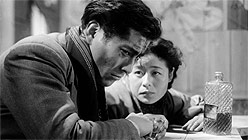Why spend the summer with Akira Kurosawa? Because you can. Any conceivable combination of the Criterion Collection’s AK100: 25 Films by Akira Kurosawa DVD box and the Pacific Film Archive’s Akira Kurosawa Centennial is recommended.
The PFA’s program, beginning tonight with a double feature of Rashomon and Drunken Angel, has the benefit of a big screen, plus a few films unavailable in the box. But aside from missing out on it entirely, there’s really no wrong way to survey the busy 50 years from 1943’s Sanshiro Sugata, Kurosawa’s debut, to 1993’s Madadayo, his career capstone.
True, it may seem a daunting prospect to spend the beach season embroiled in battles with stinging insects, sharp objects, festering cesspools, terminal diseases, relentless elements, cultural deformations, and national identity crises. But try to think of it as indulgent escapist nostalgia, for a return to that great mid-century moment when world cinema as we know it began inventing itself.
Anyway, it becomes periodically necessary to revisit the filmmaker’s work just to excavate it from his own enormous legacy, in which East and West and Past and Future can be seen colliding. “The first Japanese director seen by the West,” as biographer Stephen Prince reminds us in a preface to the DVD set, “Kurosawa’s international tastes made him the perfect emissary for foreign viewers, and his bold synthesis of artistic traditions epitomized cinematic modernism.”
Clearly he got a lot from the great Russian writers (The Idiot from Dostoevsky, The Lower Depths from Gorky, Ikiru from Tolstoy’s The Death of Ivan Ilyich), and from a certain greatest English one (with Throne of Blood as a Noh Macbeth, Ran as a Sengoku-era battle-epic King Lear, and The Bad Sleep Well, a riff on Hamlet that Francis Ford Coppola later described as “better than Shakespeare”). And he gave back much more than a fleeting frisson, having since inspired — from major names including Leone, Lucas, Tarantino — some of the most imaginative ripoffs in film history.


